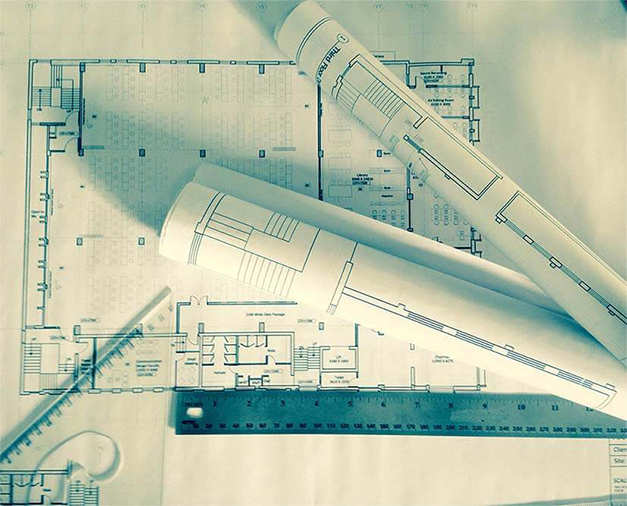Table of Contents:
- What is Interior Design?
- What is Interior Architecture?
- Overlapping Areas: Intersections between Interior Design and Interior Architecture
- Key Differences: Interior Design vs. Interior Architecture
- Career Opportunities and Job Roles
- Educational Pathways and Training
- Industry Trends and Emerging Practices
- A Passion for Spaces!
- FAQs

Are you passionate about visualising spaces and planning them for unparalleled aesthetics and functionality? A path in the interior design industry could be the one for you.
With a plethora of domains like interior designing, interior architecture, lighting design, corporate interior design, and many more, the industry opens up several career options. According to BusinessWire, the global market for interior design services is expected to hike at 7.8% CAGR in the period of 2020 to 2027.
What is the difference between interior design and interior architecture? Read more to find out.
What is Interior Design?

Interior designing is a blend of creativity with science to curate enclosed spaces that are aesthetic and functional. An interior designer develops functional layouts and visualizes a holistic space.
The key responsibility of a designer is to compose a mood board offering cohesive design. Design elements could either be borrowed from a particular style or an eclectic mix of different trends. An interior designer works under a broad spectrum ranging from a single room to commercial complexes.
Responsibilities of an Interior Designer
- Development of design concepts and working drawings.
- Selection of patterns, hues, textures, and furniture.
- Understanding the client’s brief and translating them into creative proposals.
- Management of on-site work and timely delivery within budget.
- Ensuring safety standards in the interiors.
What is Interior Architecture?

While interior design works for the enhancement of a space, interior architecture addresses structural elements as well. An interior architect guides the positioning of windows, doors, building services, etc. for a more pleasing design.
This practice is all about innovatively designing space to maximise its utility. Interior architects focus on the material palette, functionality, and ornamentation of the spaces.
Interior architecture is majorly associated with adaptive reuse where a sensitive approach is practised to retain the historical significance of a room.
Responsibilities of an Interior Architect
- Proposing concept designs for better functionality and design.
- Considering sustainable remodeling in the case of adaptive reuse.
- Staying looped in from the conceptual stages to proposing material specifications.
- Collaborate with diverse teams for a smoother workflow.
Overlapping Areas: Intersections between Interior Design and Interior Architecture

Interior design and interior architecture work on the same lines where both cater to the enhancement of internal spaces. While architecture takes care of a structure’s envelope, the enclosures are handled by interior designers and interior architects.
There is a basic overlap between the roles and responsibilities involved in both professions.
Time and Budget Management
Both interior designers and interior architects work within the scheduled timelines. On-time project delivery within the budget is the key responsibility handled by both designers.
Colour and Material Palettes
Although an interior architect additionally takes up the responsibility of alteration in structural elements, the basic remains common for both domains. Both are responsible for selecting furniture style, tones, textures, and the best-suited materials for interior spaces.
User-centric Approach
Whether it’s an interior architect or an interior designer, both professionals need to have a basic understanding of human behaviour. It not only helps in the careful crafting of spaces but also enriches the user experience through their designs.
Collaborative Working
Design is a result of efficient collaboration within diverse teams. Another overlapping role of both professionals is collaborating with all the stakeholders to guarantee seamless workflow and reduce the risks of error.
Structural Alterations vs Spatial Setting
Building Codes
Spatial and Interior Designer
Technical Designer
Interior Decorator
Project Manager
Furniture Designer
Lighting Designer
Approach to Become an Interior Architect
Approach to Become an Interior Designer
Versatility in Spaces
Eco-friendly-ness in Designs
Welcoming the Breakthroughs
Key Differences: Interior Design vs. Interior Architecture

An interior architect deals with the technical part and is involved in the structural aspect along with delivering unparalleled aesthetics. Whereas, an interior designer picks up spaces as a blank canvas and paints the picture with a spatial setting.
Interior architects collaborate with several technicians for rebuilding or remodelling an existing structure. Designers focus more on planning for maximised efficiency and adding a cohesive design theme.
Interior designers usually prioritise the aesthetic and decorative elements while designing the space. Whereas, an interior architect works in compliance with the structure, building codes, and spatial planning along with catering to the aesthetics.
Career Opportunities and Job Roles

The key role of a spatial designer is to understand the brief given by the client and plan utilitarian spaces. An interior designer also works on the mood board, costing, and on-site supervision. The designer has to stay tuned to the latest styles emerging in the industry to generate new-age spatial solutions.
The job role of a technical designer is to use software and generate a set of working drawings. Designs are curated by considering the legal building codes and design specifications. The major responsibility of a technical designer is to be precise in details. A specialised career opportunity grows as a part of interior architecture where the technical designer designs, analyses, and gets the proposal executed on time.
The primary responsibility of an interior decorator is to define aesthetics in spaces. After the entire design of the room is done, an interior decorator collaborates with vendors and contractors to finalise materials, furnishings, and decorative accessories.
A project manager generates a timeline for the associated project to ensure delivery within the time and budget. They are responsible for the generation of detailed timelines for each task, material, and coordination with the involved team members.
Both interior designers and interior architects can enter the furniture design industry. A furniture designer is responsible for designing the entire furniture item from scratch. The typical workflow includes developing a concept, working on the shop drawings, finalising colours and finishes, and getting the furniture item built.
A lighting designer works on the play of light and shadow through fixtures. This job profile includes the generation of lighting effects through strategic placement of fixtures that promise adequate lighting while building an ambience.
Educational Pathways and Training

There are several paths to pursue studies in interior architecture after completing 10+2. The candidate can either opt for a 5-year undergraduate course in B.Arch (Bachelor of Architecture) interior design or consider pursuing a BA (Bachelor of Arts) in interior design.
Graduates from the design field can go for post-graduate programmes by opting for M.Arch in interior design. The 2-year long programme demands a prerequisite degree in a relevant subject with the minimum specified score. Apart from formal educational programmes, students can also consider certified courses in their field of interest.
No matter which educational path you opt for, going for training or an internship is a must. Internships help you get insights into the challenges and practical solutions that lie in the interior architecture industry.
Students can opt for various interior designing courses after completing their 10+2 with aggregate scores. A few of the formal educational programmes are B.Sc in Interior Design, Diploma in Interior Design, and Bachelor of Arts.
Candidates can further go for M.Sc or MBA in Interior Design for better career opportunities and learning. Internships during the course are vital as it tells about the critical aspects of design that need to be taken care of.
Industry Trends and Emerging Practices

With the bustling urbanisation and evolving lifestyles, the demand for interior design is increasing at a significant pace. Designs are adapting intelligent design solutions for smarter living. A few of the common emerging trends are:
The current lifestyle demands flexibility to transform spaces as per the condition. Majorly arose due to the hybrid work mode, multifunctional spaces are an answer to the emerging challenge of adding more than a single purpose for one space.

Eco-friendliness is more of a necessity than a mere trend in the design industry. Sustainable practice in interiors prioritises the adoption of natural materials and local construction techniques that help in minimising the carbon footprint.

Suzlon One Earth is one such corporate design in Pune by Ar. Charles Christopher that’s sustainable and one of the earliest LEED-rated Indian buildings. This campus is the first 100% energy campus in India.
With all the industries going digital, interiors are adopting technology too. The design industry integrates the latest technology to enhance efficiency and comfort in spaces.

Scion Innovation Hub by RTA Studio and Irving Smith Architects adopts technology in its construction and engineered spaces.
A Passion for Spaces!
Interior design along with interior architecture exhibit a passion for spaces. It’s all about diving deep into the details and developing precise designs that enrich the look, experience, and functionality of the room. Before picking one path, analyse the possibilities offered in both and opt for the one that speaks to your passion and abilities.
FAQs
1. Is architecture a more challenging course than interior design?
Although architecture and interior design both deal with designing and spaces, each of them faces unique challenges in the process.
2. What is interior architecture?
Interior architecture is all about redesigning interior spaces with a sensitive approach towards aesthetics and functionality.
3. Can an interior designer be considered an interior architect as well?
No. Interior designers focus just on the aesthetics, whereas, an interior architect is involved in structural alterations.
4. Which is a better earning profession– interior designing or interior architecture?
Both interior designing and interior architecture earn almost the same amount. However, an Interior Architect will always have a wide skill set with deeper technical knowledge.






